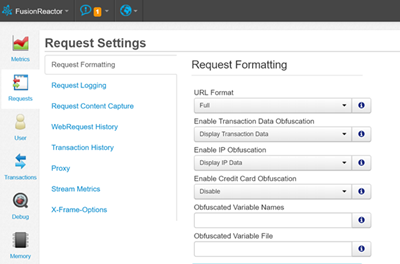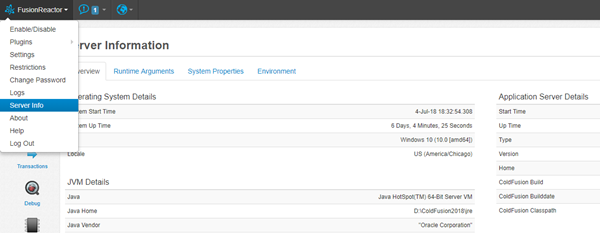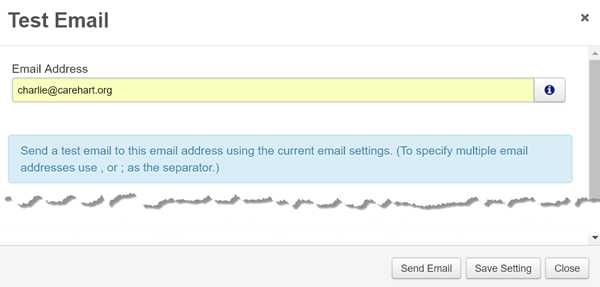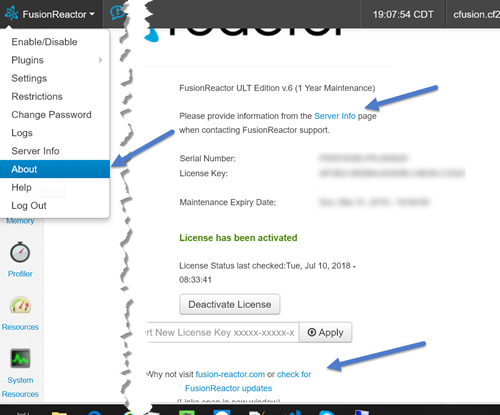What's new in FusionReactor 7.3 - over a dozen useful new features and enhancements
Note: This blog post is from 2018. Some content may be outdated--though not necessarily. Same with links and subsequent comments from myself or others. Corrections are welcome, in the comments. And I may revise the content as necessary.FusionReactor (my favorite server monitor) continues its onward march of refinement and improvement with its latest release which came out last week, 7.3. In this post, I highlight over a dozen of its new features and improvements.
You can find them (and three dozen bug fixes) listed also in the FR "release notes" technote (https://www.fusion-reactor.com/support/kb/frs-431/). BTW, that technote covers not just 7.3 but each of the prior FR 7 releases and point releases, which is helpful if you may be skipping over releases (you only need ever install the latest, if that's what you want, as they are cumulative).
Still more optional obfuscation of GDPR/privacy data
 Previous FR versions have offered various ways (and an increasing number) of options for obfuscating data, starting with FR6's addition of optional obfuscation of SQL text (JDBC>Settings>Transaction Settings) and for MongoDB (Transactions>Settings>Mongo Transactions), to FR 6.2's optional obfuscation of request data (of form post headers, as enabled in Requests>Settings>Request Formatting), to FR7's obfuscation of credit card data (also on that Request Formatting tab of Requests>Settings), and more.
Previous FR versions have offered various ways (and an increasing number) of options for obfuscating data, starting with FR6's addition of optional obfuscation of SQL text (JDBC>Settings>Transaction Settings) and for MongoDB (Transactions>Settings>Mongo Transactions), to FR 6.2's optional obfuscation of request data (of form post headers, as enabled in Requests>Settings>Request Formatting), to FR7's obfuscation of credit card data (also on that Request Formatting tab of Requests>Settings), and more.
FR 7.3 now adds the option of obfuscating the request IP address, enabled also on that same Requests Formatting tab. This and the others aid in meeting GDPR and other security/privacy requirements. For more on these settings, see the "i" icon next to each option in the FR UI, or see the FusionReactor documentation.
"Server Information" page enhancements
Have you noticed that recent versions of FusionReactor offer a new "Server Information" page? It's found on the "FusionReactor" menu (which many people also never even notice, at the top left of the FR UI). The Server Info page has a few tabs of info including an overview of your server, application server, JVM runtime info and properties values, and OS environment variables.
All these can be used to understand the nature of your environment. Indeed, one new feature of 7.3 is a newly available "copy to clipboard" button, allowing you to copy this info to help in generating support cases (with FR support folks or others).
But FR 7.3 also adds a few new kinds of information about your environment, on the page's "Overview" tab.
First, notice the new "server start time" and "server up time", which are each shown under the "Operating System Details" (top left) section of the page.
Note that these are in fact about the *server* up time, not your application server. That information (the start and up time of your application server) was already listed on the same page, in the "Application Server Details" on the top right of that "overview" tab. (FWIW, the Metrics>Web Metrics page has long shown the startup and uptime info for the *instance*, though sadly even in 7.3 it still labels it as the "server" started and uptime, which has confused some users. I have made a feature request for that with the team.)
The second new kind of information on the page is about FR itself. See the "FusionReactor Details" on the lower right of the same "Overview" tab on the page (above "network details"), which now includes information about the FR version, license, instance name, and more. Previously, this version information was only found on the "About" page (via that top-right FusionReactor menu).
And there's a related improvement: previously, until you activated an FR license, that "About" page was all that one could see when they accessed FR. A new feature in 7.3 is that this entire "Server Information" page is now able to be viewed even before an FR license has been implemented. This can be used to debug licensing activation failures and again, with the new "copy to clipboard" button, can be sent to FR support folks. You won't see the FR menu, though. Instead, on that equivalent of the about "page", you will see a new sentence and link:
Please provide information from the Server Info page when contacting FusionReactor support.
And clicking that link will take you to that "about" page. (You can see this also in the last screenshot below.)
In email settings page, changes to the "to" address can be saved while testing
This is one of those little things that you might never encounter unless and until you configure FR send email (which everyone should do, to then automatically receive FR's helpful Daily Reports at least, and also to get Crash Protection emails, if enabled). But if you ever setup that mail configuration (in FR's FusionReactor>Settings>Email Settings page), you may have noticed that if you have entered mail server and email values, and saved them, and then tried to test them with the "send test email" button, but you then had need to change the TO address value(s) while testing, it turned out that those changes were NOT saved back to the settings page.
In FR 7.3, you can now proceed to make changes to the "To address" value(s) and test them on the test page (popup), but notice that on the test page popup you will find there is now a "save settings" button, which will save those changes of the To address back to the settings page (and indeed, they are saved to the FR configuration also).

One point of clarification: this does not change or address the long-standing challenge some have had, where if while they initially configuring the various mail settings on that page, if they do do NOT SAVE them before using that "send test email" button, they find that those other changes (like the mail server and from address) will be lost if they don't use the "save settings" on the lower right of the mail settings change. (The new feature is only a new button on the "send test email" popup page and it applies only to the values you can change on that test page: the "to address".)
So just as I have warned people for years (in consulting and training sessions): it's still important that you use the "save settings" button first BEFORE using "send test email", if you make changes before testing!
Enhancements for specific platforms
There are a few FR 7.3 enhancements which are specific to particular platforms that FR supports.
First, FR 7.3 adds support for Java 10 (FR 7.2 had added support for Java 9), and it also adds support for ColdFusion 2018 (in beta as of this writing) as well as CF2018 Solr.
(ColdFusion shops who have not previously considered how FusionReactor can monitor Solr can find it listed in the FRAM Instance Manager, but to see it you must change the Instance Manager's "scan system" feature to search *3* levels down in the file system(versus its default of searching 2 levels down), as CF's Solr implementation is found in the [cf]\cfusion\jetty folder. That change will generally add only another minute or so to most scans, but YMMV.
Indeed, folks using FR on any platform may be surprised to find out what else FR can monitor, by letting the scan system search further down into the file system. Or you can see what it can monitor (generally) using the "Technologies" menu on the toolbar at the FR web site, fusion-reactor.com.)
There are also improvements for other platforms, of course. Next, and related to the aforementioned "System Information" page, FR has long offered on that page information about your application server, such as ColdFusion, Lucee, Tomcat, etc. An improvement in 7.3 is that the page now supports showing version information for those running on JBoss as well. And FusionReactor 7.3 can now also detect the server on which a Commandbox instance is running.
Finally, those using Tomcat will find that FR now attempts to capture the log files from Tomcat (such as catalina.out, localhost.log etc) to be archived along with the normal FR logs. As with all FR logs, only the current hour worth of log data will be excerpted and archived, though that will be done each hour by default.
FusionReactor has long done the same sort of excerpting of ColdFusion's console log, the ColdFusion-out.log, which appears in the FR logs as fr-coldfusion-log.log (that's not a typo). In the case of Tomcat, the log catalina and localhost file names will show up in the FR logs with the names juli-catalina.log and juli-localhost.log, respectively. Finally, the Tomcat stderr.log is archived by its original name.
Having these logs for the application server available while reviewing FR logs can be very helpful, especially for post-crash troubleshooting.
FusionReactor Cloud enhancements
Wrapping up this discussion of the enhancements in FR 7.3, there are several enhancements related to FR Cloud.
If you wonder what FR Cloud is, note first that FusionReactor is offered in two forms. The traditional form is an on-premise implementation, where FR is enabled within the JVM of the application to be monitored, as a JVM "agent" (as a -javaagent. That's transparent to most users, as a mere technical detail.)
Then, in the FusionReactor 7 timeframe, yet another form of deployment was added--really an extension to this traditional on-premise one, called FusionReactor Cloud. It gives you all the benefits of FusionReactor on-premise (you still install it that way) plus it gives extended data retention, application focused metrics, advanced alerting capability, and more, all stored in the cloud and accessible to only you, the FR Cloud account holder. For more on FR Cloud, see https://www.fusion-reactor.com/fusionreactor-cloud/.
 Among the improvements added in FR 7.3, for the benefit of FR Cloud users, are first the ability to see an indication of an active profile for a request that is running and being profiled.
Among the improvements added in FR 7.3, for the benefit of FR Cloud users, are first the ability to see an indication of an active profile for a request that is running and being profiled.
This and several other new features leverage something referred to internally (and in the FR updates technote) as the "Immediate Request API", or IR, as you will see mentioned in the update technote. This is part of the powerful communication that happens bidirectionally between FR Cloud and an on-premise implementation (the instance being monitored).
Another benefit of the improvement to communication in 7.3 is FR now being able to send more profile entries to FR Cloud by default. There's also improved error handling and feedback when using the feature to start/stop Profiling of requests from FR Cloud. And thread dumps taken in FR Cloud now better match on-prem FR thread dumps (including more thread meta data), and subtransaction information for recent and running requests and jdbc transactions is also improved.
Finally, support has been added in FR 7.3 to allow FR Cloud to show the current FR logs being created in the FR on-prem edition, and to allow you to delete/clear those logs from the cloud. (As of this writing, that functionality is not yet appearing in the cloud UI but it should appear soon. That's one of the other benefits of the FR Cloud edition, whereby changes to it are automatically made available as they are released. There's no need for us to manage that as users of FR Cloud, though as you can see here, it is sometimes important to update the FR on-prem edition to see benefits in the FR Cloud edition.)
Conclusion; getting the update
So that's a fair bit that's new in FR 7.3, and it's not quite every change, nor have I discussed any of the dozens of bug fixes. Again, look at the FR 7 updates technote to see not only those other changes but also what was new in 7.2, 7.1, and 7. (I didn't do blog posts on those, though I wish I had. And I do in fact plan to do one on one of the most compelling features added in 7.2, "archived metrics".)
And do consider updating FR. I find (in my troubleshooting consulting) that lots of folks are still running either older versions of FR 7.x or even 6.x (or earlier!). Note that there is a "check for updates" link on the FR "about" page, which will pass in your current version and serial number and let you know if the update would be free for you.

Or you can always just download the latest version by going directly to the FR downloads page, to get either the complete installer or the jar file (which you should get depends on how FR was installed initially on your server. See help on the page there for more.). FR updates are "in place" updates, where the new version will simply take effect on a restart of your monitored instance. (I plan to do a blog post on updating, to share some other tips.)
If you need help with installing or using FR, or solving problems using it, such server troubleshooting is what I do for a living. Let me know how I can help.
For more content like this from Charlie Arehart:Need more help with problems?
- Signup to get his blog posts by email:
- Follow his blog RSS feed
- View the rest of his blog posts
- View his blog posts on the Adobe CF portal
- If you may prefer direct help, rather than digging around here/elsewhere or via comments, he can help via his online consulting services
- See that page for more on how he can help a) over the web, safely and securely, b) usually very quickly, c) teaching you along the way, and d) with satisfaction guaranteed








There are no comments for this entry.
[Add Comment]